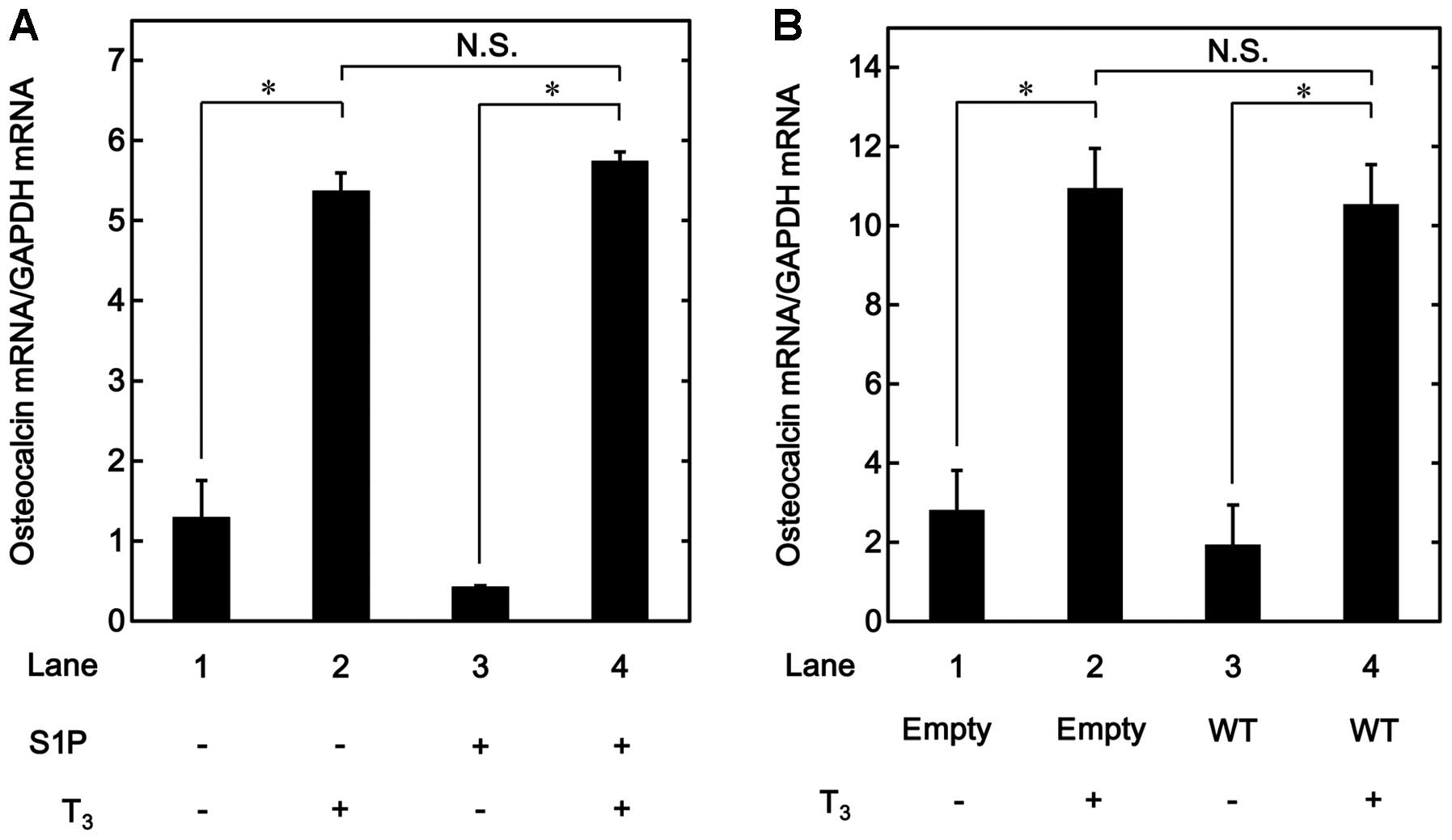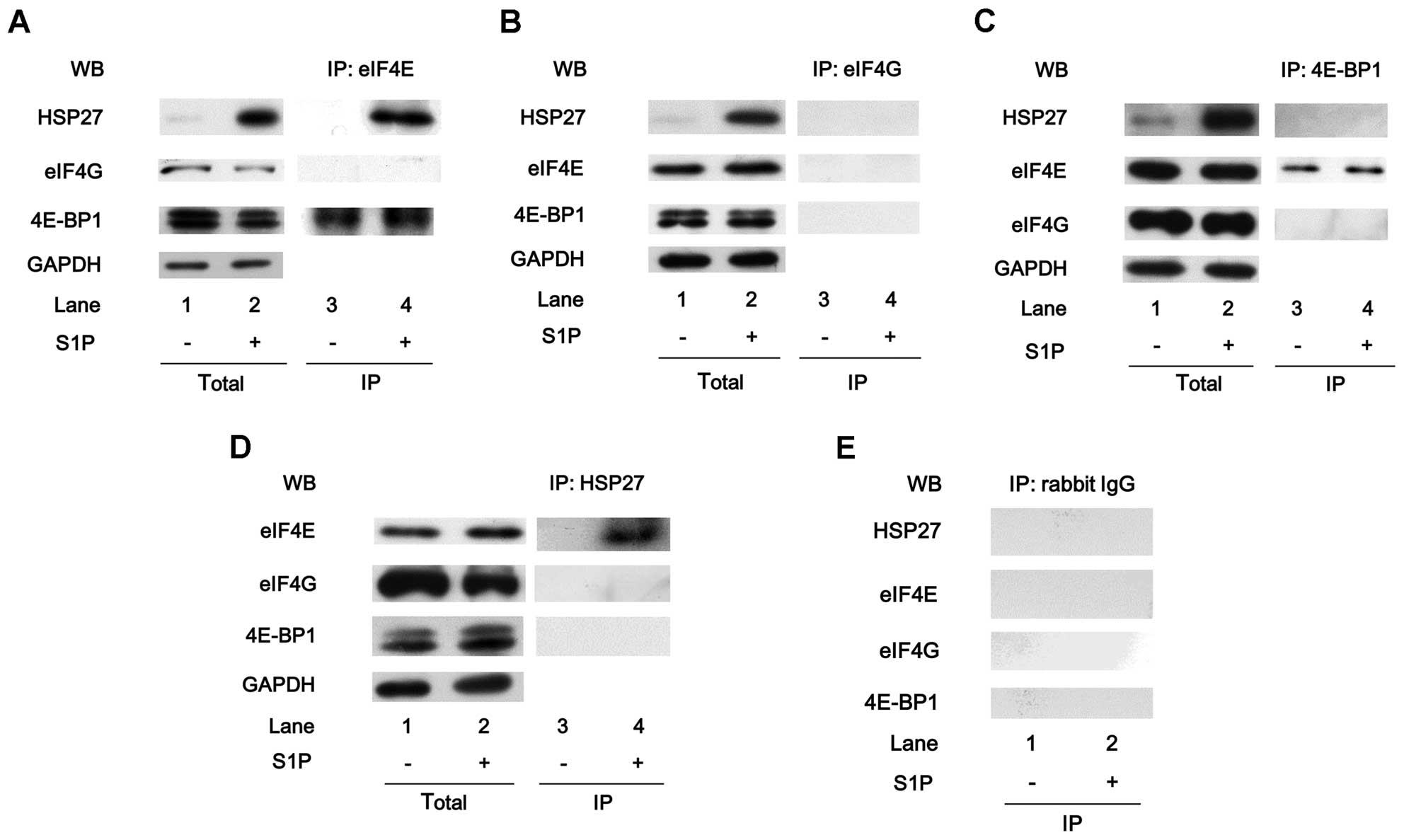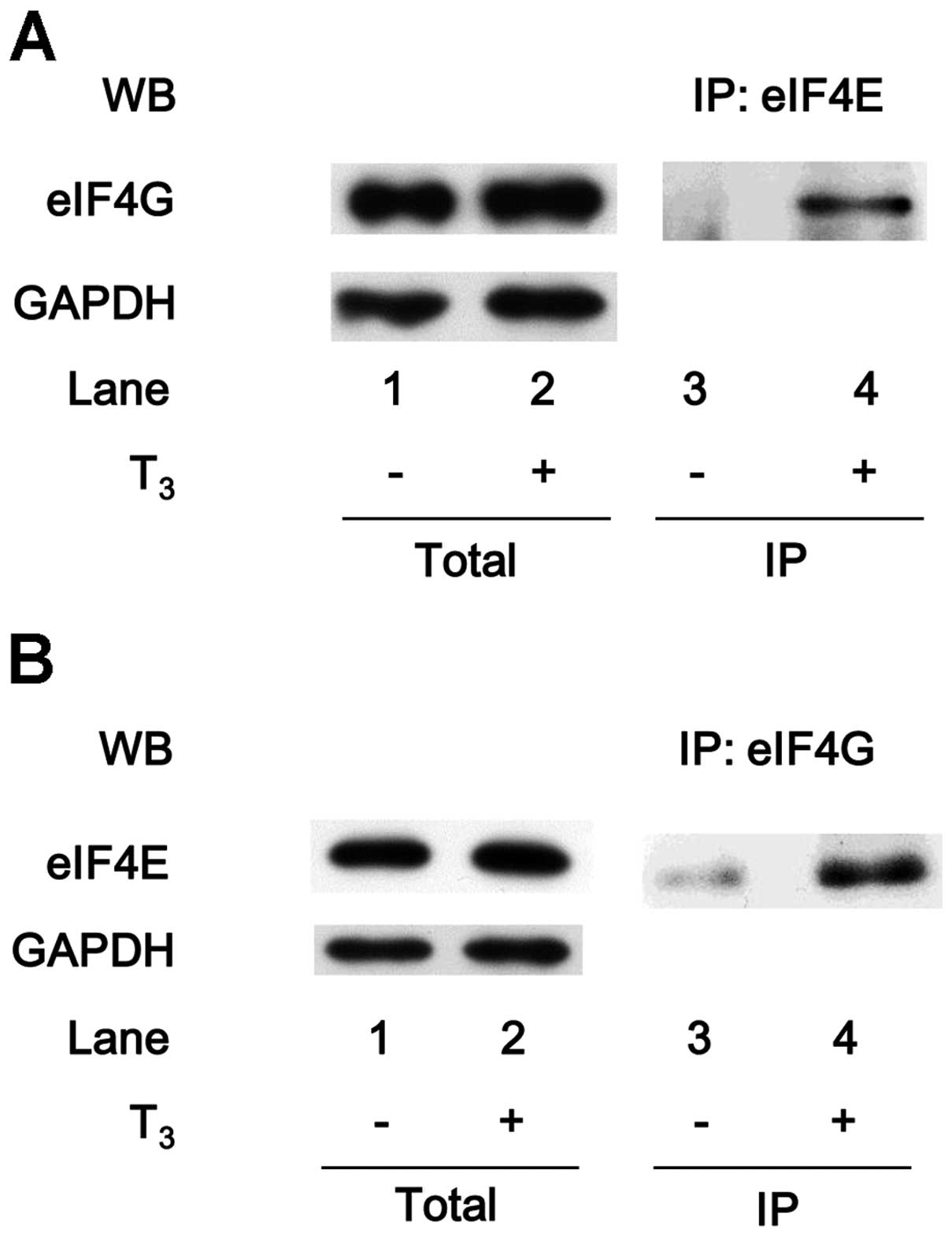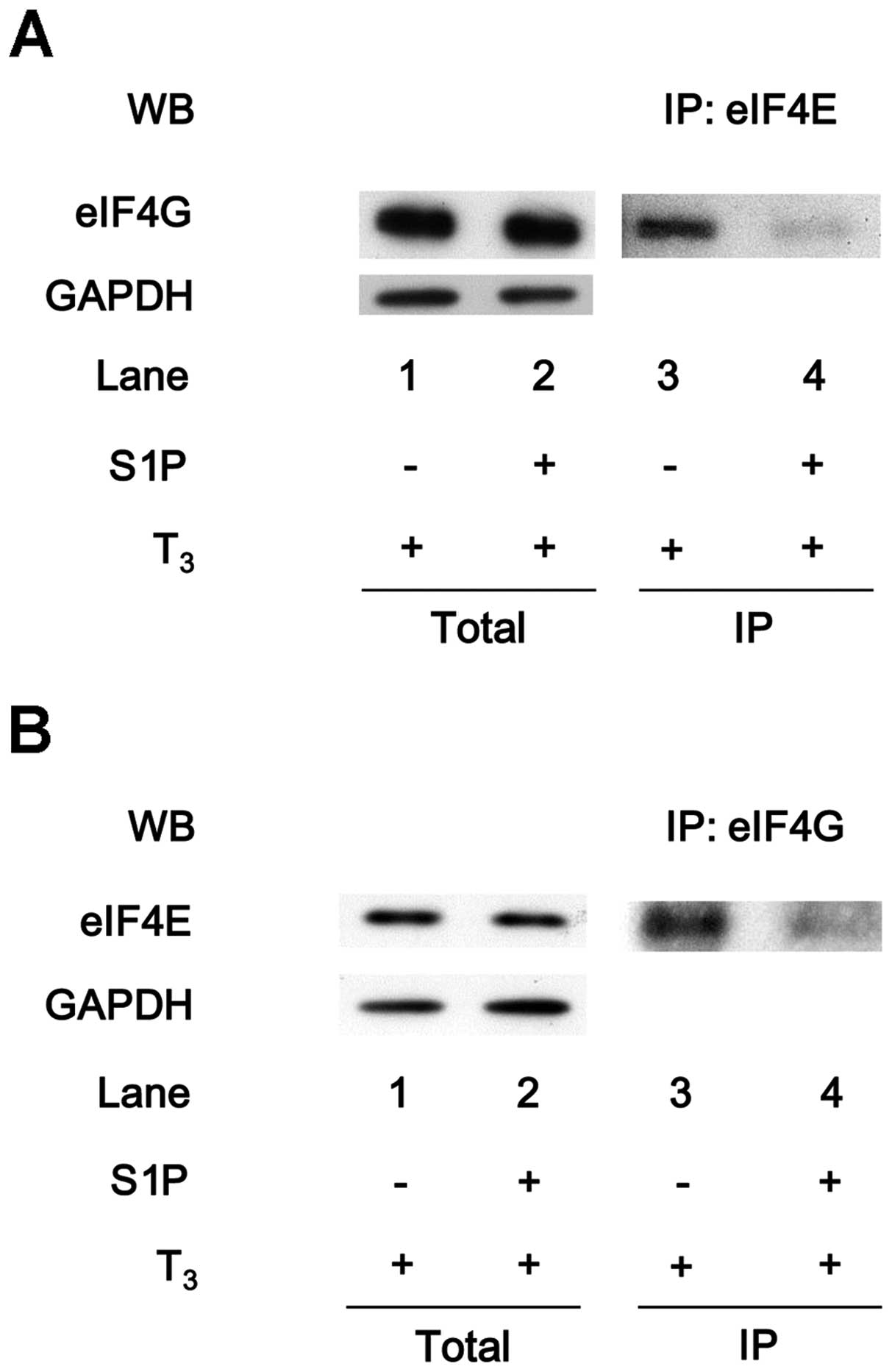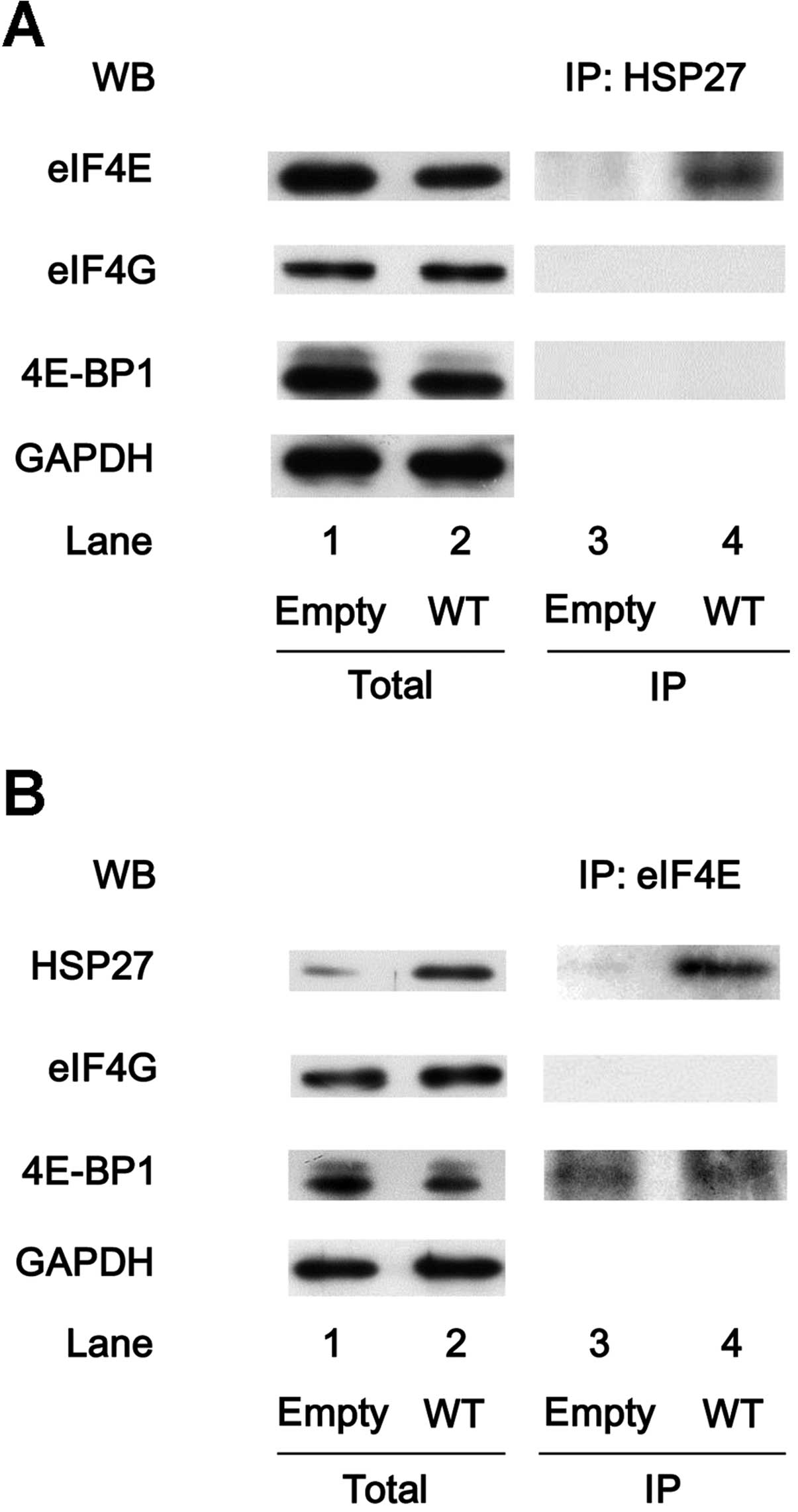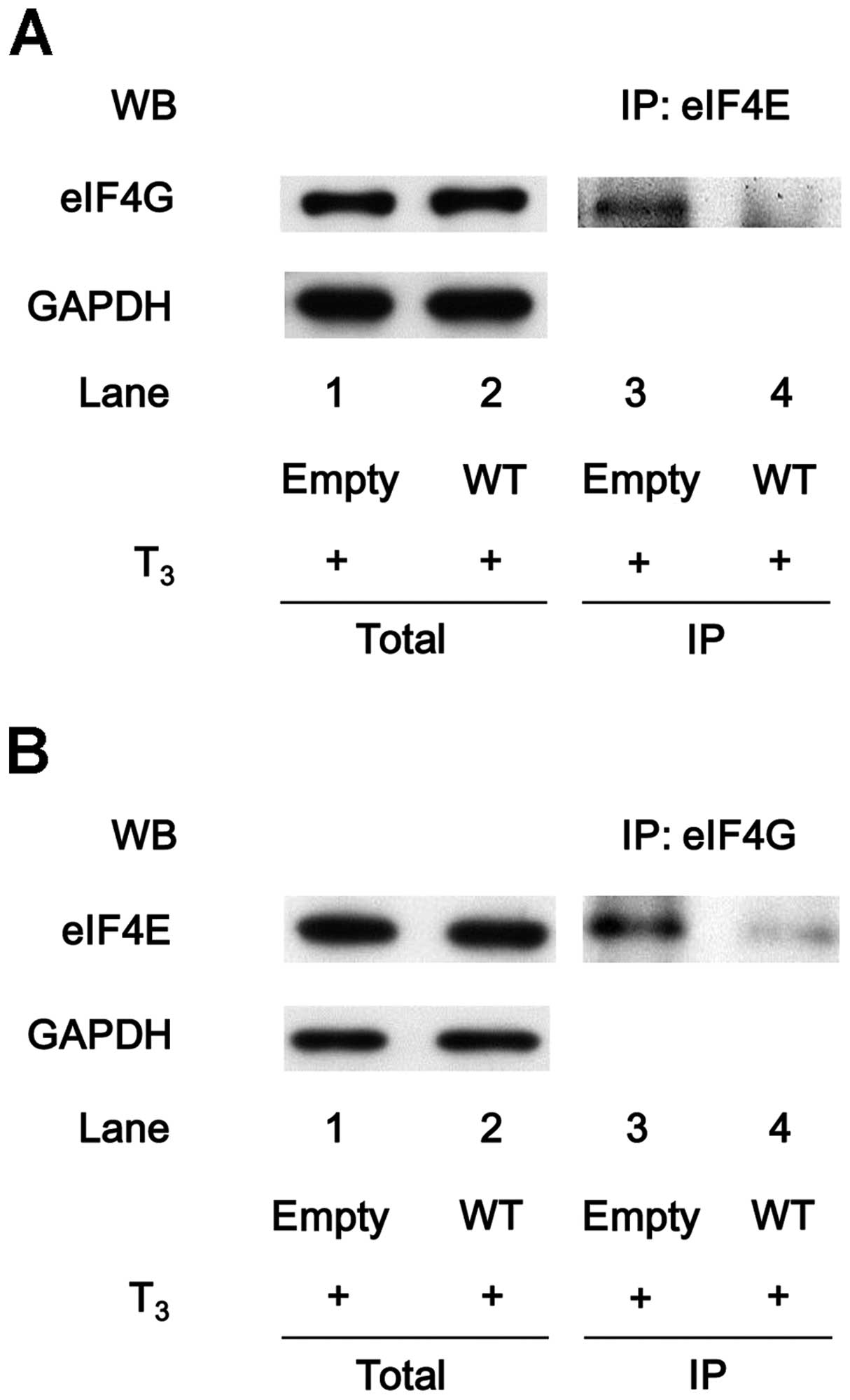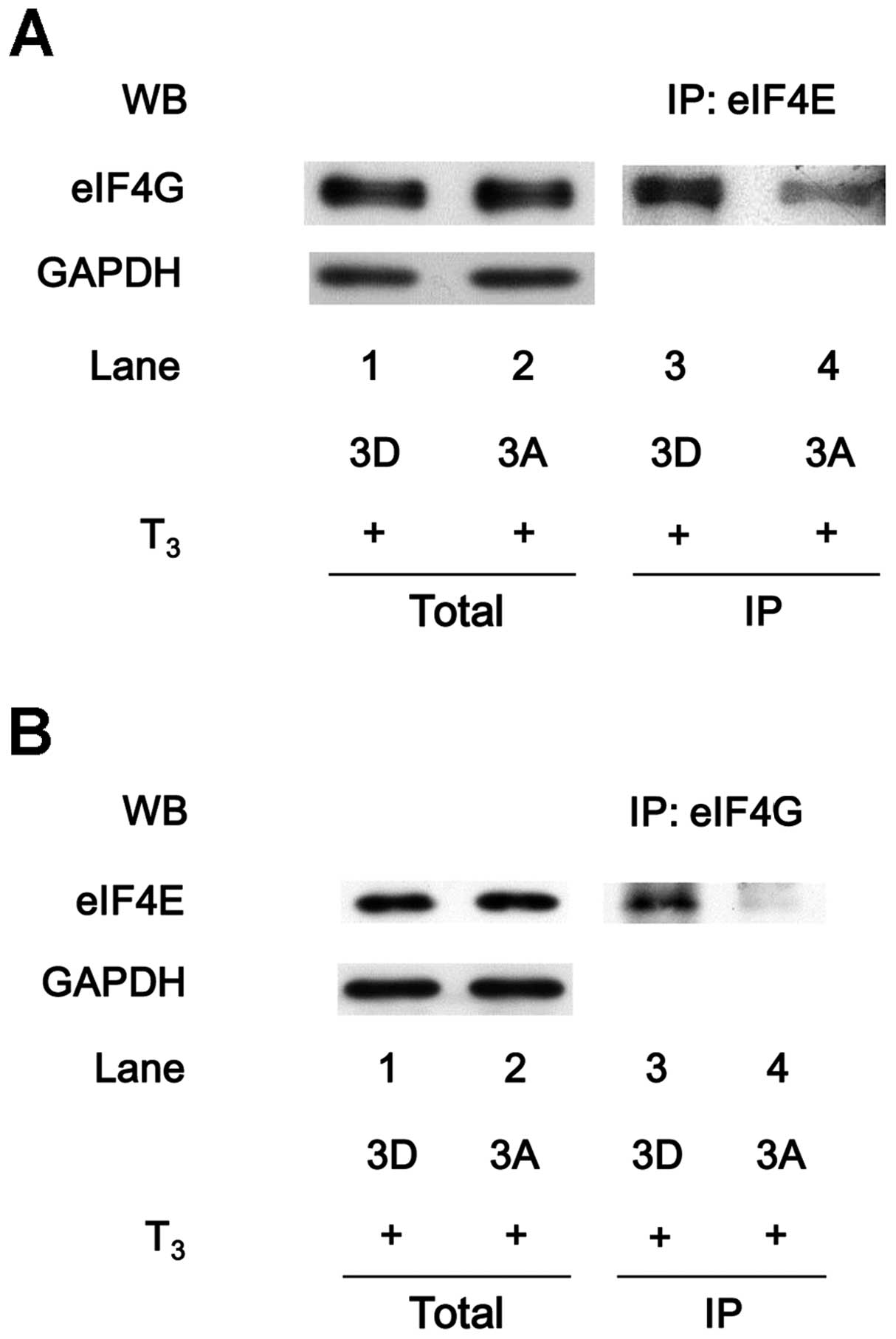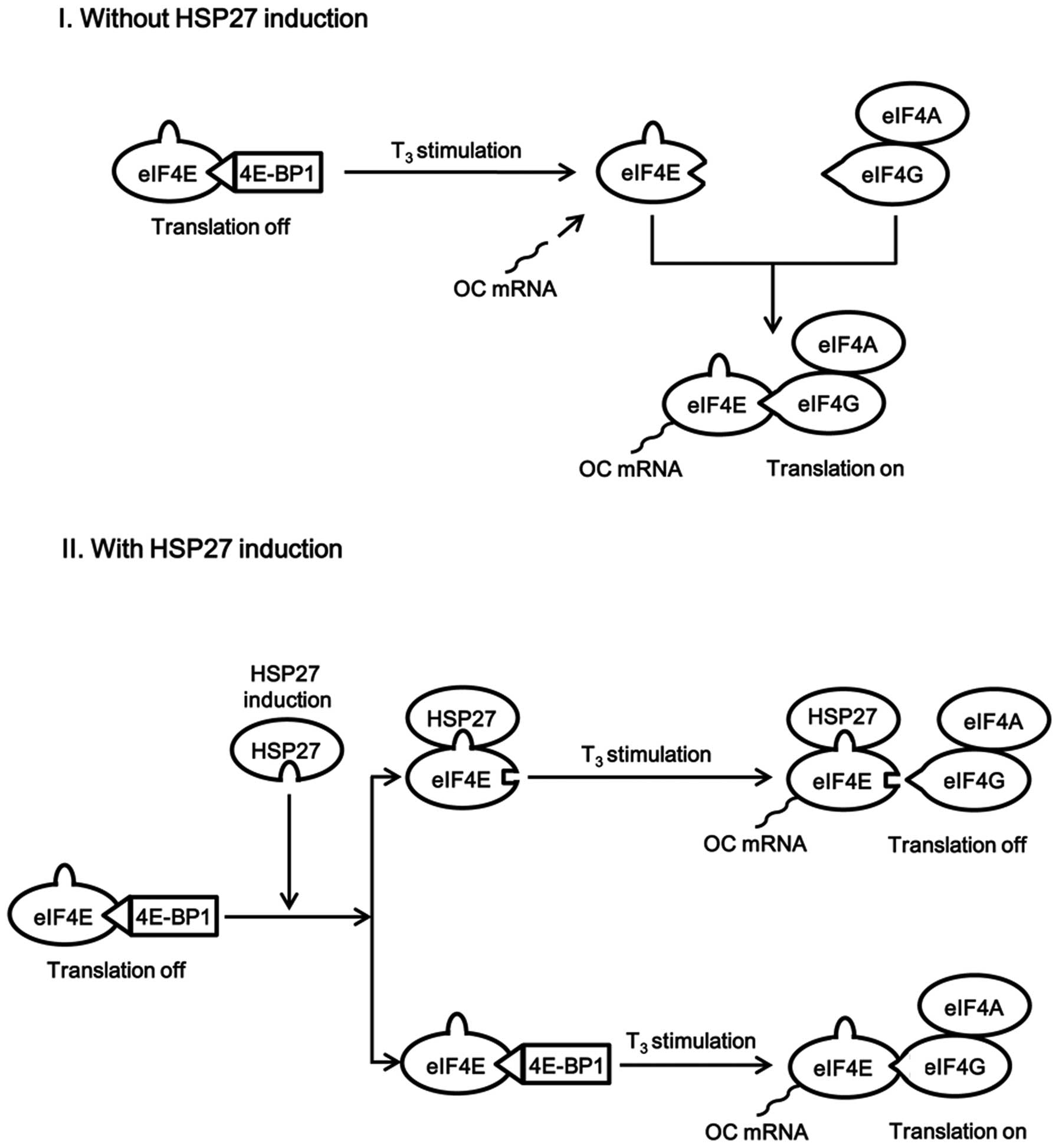Unphosphorylated HSP27 (HSPB1) regulates the translation initiation process via a direct association with eIF4E in osteoblasts
- Authors:
- Published online on: July 7, 2015 https://doi.org/10.3892/ijmm.2015.2274
- Pages: 881-889
Abstract
Introduction
Heat-shock proteins (HSPs) are induced by a variety of physiological and environmental stresses, such as heat stress (1). As molecular chaperones, HSPs facilitate the refolding of non-native proteins, or assist in their elimination via chaperone-mediated autophagy or via the ubiquitin proteasome system. HSPs have recently been classified into seven families; HSPH (HSP110), HSPC (HSP90), HSPA (HSP70), HSPD/E (HSP60/HSP10), CCT (TRiC), DNAJ (HSP40) and HSPB (small HSP) (1,2). HSP27 (HSPB1) belongs to the HSPB family, with monomeric molecular masses ranging from 15 to 30 kDa. The primary structure of HSP27 is highly homologous to other small HSPs, including αB-crystallin and HSP20, which all contain amino acid sequences known as ʽα-crystallin domains' (3). Although HSP27 is ubiquitously expressed in human cells and tissues, its functions have mainly been studied in skeletal, smooth and cardiac muscles, which have higher expression levels (1,4). The HSP27 expression level is significantly changed under various cellular conditions (1). It is generally recognized that the functions of HSP27 are regulated by post-translational modifications, such as phosphorylation. HSP27, which normally exists as an unphosphorylated oligomer, possesses three phosphorylatable serine residues (Ser-15, Ser-78 and Ser-82) (5,6). Once HSP27 is phosphorylated, a conformational change occurs from the aggregated form to the dimer (5–7). Phosphorylated HSP27 has been previously shown to suppress the growth of hepatocellular carcinoma via inhibition of extracellular signal-regulated kinase (8). However, the exact role of phosphorylated HSP27 has not yet been clarified.
Bone metabolism is strictly regulated through continuous bone remodeling in order to maintain the structural bone integrity and mineral homeostasis (9). Bone remodeling is mainly comprised of two functional events, osteoblastic bone formation and osteoclastic bone resorption (10). It has been reported that the outcome for osteosarcoma patients with overexpression of HSP27 is poorer (11). With regard to the functions of HSP27 in osteoblasts, it is reportedly involved in the balance between differentiation and apoptosis (12,13). The HSP27 protein is barely detectable in osteoblasts under unstimulated conditions (14). In our previous study (15), we demonstrated that the level of HSP27 is low in unstimulated osteoblast-like MC3T3-E1 cells. In addition, we reported that various physiological stimuli, including sphingosine-1-phosphate, are able to induce the expression of HSP27 protein in these cells, and that the induced HSP27 is in the unphosphorylated form (16,17). Furthermore, unphosphorylated HSP27 has a suppressive effect on the osteocalcin (OC) synthesis induced by triiodothyronine (T3) in MC3T3-E1 cells (17). However, the mechanisms underlying the inhibitory effects of HSP27 on osteoblasts remain to be elucidated.
Evidence is accumulating that HSP27 (HSPB1) interacts with clients regulating gene expression (18). The signal transducer and activator of transcription 2 (STAT2) protein, which is a crucial transcription factor, is reportedly degraded in cells following the downregulation of HSP27, indicating that HSP27 acts as a regulator of transcription (19). In addition, it has been shown that the HSP27-eukaryotic translation initiation factor 4E (eIF4E) interaction decreases eIF4E ubiquitination and proteasomal degradation in advanced prostate cancer cells, and HSP27 has been demonstrated to confer resistance to androgen ablation and chemotherapy through eIF4E (20). It has been firmly established that eIF4E is an mRNA cap-binding protein and has a crucial role in translational control (21,22). eIF4E binds to eIF4G in response to stimulation, and forms the eIF4F complex with eIF4A during the mRNA translation process (23). eIF4E assembles the mRNA into this complex and promotes the ribosome recruitment. In addition, eIF4E is negatively regulated by 4E-binding protein 1 (4E-BP1), which competes with eIF4G, and under unstimulated conditions, 4E-BP1 binds to eIF4E by occupying the same binding site for eIF4G (24). In the present study, in order to investigate the exact mechanism by which unphosphorylated HSP27 suppresses T3-stimulated OC synthesis in osteoblasts, the molecular targets of HSP27 were explored using osteoblast-like MC3T3-E1 cells with HSP27 overexpression. Unphosphorylated HSP27 was shown to associate with eIF4E in osteoblasts and suppress the translation initiation process.
Materials and methods
Materials
T3 and sphingosine-1-phosphate were purchased from Sigma-Aldrich (St. Louis, MO, USA). HSP27, glycer-aldehyde-3-phosphate dehydrogenase (GAPDH) and rabbit immunoglobulin G (IgG) antibodies were purchased from Santa Cruz Biotechnology, Inc. (Dallas, TX, USA). The rabbit monoclonal eIF4E (#2067), rabbit monoclonal eIF4G (#5169) and rabbit 4E-BP1 (#9452) antibodies were purchased from Cell Signaling Technology, Inc. (Danvers, MA, USA). Wild-type (WT) HSP27 and mutant human HSP27s subcloned into the pcDNA3.1(+) mammalian expression vector were kindly provided by Dr C. Schafer (Klinikum Grosshadern, Ludwig-Maximilians University, Munich, Germany). For mutant HSP27 vectors, the HSP27 cDNAs were mutated from serine residues (Ser-15, Ser-78 and Ser-82) to alanine (3A) to prevent the phosphorylation of HSP27, or were mutated to aspartic acid (3D) to imitate the phosphorylated HSP27 form, as described previously (25). The eukaryotic expression vector, pcDNA3.1(+), Dynabeads Protein A and TRIzol reagent were purchased from Life Technologies (Carlsbad, CA, USA). The Omniscript Reverse Transcriptase kit was purchased from Qiagen (Hilden, Germany). FastStart DNA Master SYBR-Green I was obtained from Roche Diagnostics K.K. (Basel, Switzerland). The Bicinchoninic Acid Protein Assay kit was purchased from Thermo Fisher Scientific, Inc. (Waltham, MA, USA). An ECL Western Blotting Detection System was purchased from GE Healthcare UK, Ltd. (Buckinghamshire, UK). Other materials and chemicals were obtained from commercial sources. Sphingosine-1-phosphate was dissolved in dimethyl sulfoxide. The maximum concentration of dimethyl sulfoxide was 0.1%, which did not affect the assay for OC or the detection of protein expression by a western blot analysis.
Cell culture
Cloned osteoblast-like MC3T3-E1 cells derived from newborn mouse calvaria (26) were maintained as described previously (27). Briefly, the cells were cultured in α-minimum essential medium (α-MEM) containing 10% fetal bovine serum (FBS) at 37°C in a humidified atmosphere of 5% CO2/95% air. The cells were seeded in 35-mm dishes (5×104 cells/dish) in α-MEM containing 10% FBS. After 5 days, the medium was exchanged for α-MEM containing 0.3% FBS. The cells were used for experiments after 48 h.
Transient transfections
For transient transfections, the MC3T3-E1 cells were seeded in 35-mm dishes (1.5×104 cells/dish) in α-MEM containing 10% FBS. After 4 days, the cultured cells were transfected with 1 µg of the WT HSP27 plasmid or control (empty) pcDNA3.1(+) vector using the UniFECTOR transfection reagent (B-Bridge International, Mountain View, CA, USA) in 1 ml of α-MEM medium without FBS. Five hours after transfection, 1 ml of medium with α-MEM containing 0.6% FBS was added. At 3 days after transfection, the medium was removed, cells were washed with 2 ml of α-MEM medium without FBS, and were incubated in α-MEM with 0.3% FBS for co-immunoprecipitation or reverse transcription-quantitative polymerase chain reaction (RT-qPCR) experiments. The cells were subsequently cultured for another 6 h.
Establishment of stable HSP27-transfected cells
The stable HSP27-transfected cells were established as described previously (17). Briefly, the MC3T3-E1 cells (5×105 cells) were transfected with 2 µg of the WT, mutant 3A or 3D HSP27 plasmids expressing geneticin (G418; EMD Chemicals, Inc., San Diego, CA, USA) resistance using UniFECTOR transfection reagent in α-MEM without FBS, and were incubated in the presence of 400 µg/ml of G418. The transfected cells were seeded in 35-mm dishes (5×104 cells/dish) in α-MEM containing 10% FBS and 200 µg/ml of G418. After 5 days, the medium was exchanged for α-MEM containing 0.3% FBS and 200 µg/ml of G418. The cells were used for experiments after 48 h.
Protein preparation
For co-immunoprecipitation studies, the cultured MC3T3-E1 cells or transfected cells were lysed in ice-cold TNE lysis buffer [10 mM Tris/HCl (pH 7.8), 1% Nonidet P-40, 150 mM NaCl, 1 mM EDTA, 1 mM dithiothreitol, 1 mM sodium fluoride, 1 mM sodium vanadate and protease inhibitor cocktail (Roche Diagnostics K.K.)]. The lysates were subsequently centrifuged at 10,000 × g at 4°C for 30 min, and the supernatant was collected as TNE soluble protein. For the western blot analysis of HSP27, eIF4E, eIF4G, 4E-BP1 or IgG, the cultured MC3T3-E1 cells were pre-treated with 30 µM of sphingosine-1-phosphate or vehicle for 6 h to induce HSP27, and were stimulated by 3 nM of T3 or vehicle for 24 h. The HSP27 cDNA-transfected cells were stimulated by 3 nM of T3 or vehicle for 24 h. Following stimulation, the cells were lysed, homogenized and sonicated in lysis buffer containing 62.5 mM Tris/HCl (pH 6.8), 2% sodium dodecyl sulfate, 50 mM dithiothreitol and 10% glycerol.
Co-immunoprecipitation
Co-immunoprecipitation was performed as described previously (28). Briefly, the indicated antibodies were added to the TNE-solubilized proteins, and the mixture was agitated gently overnight at 4°C, followed by the addition of Dynabeads Protein A and incubation for a further 1 h with continuous mixing. Protein immunocomplexes were isolated using a magnetic particle concentrator. The immunoprecipitated proteins and the TNE-soluble proteins (for analysis of the total protein) were analyzed by western blot analysis.
RT-qPCR
The cultured MC3T3-E1 cells were pre-treated with 30 µM of sphingosine-1-phosphate or vehicle for 6 h to induce HSP27, and were stimulated by 3 nM of T3 or vehicle in α-MEM containing 0.3% FBS for 3 h. Transiently HSP27-overexpressing cells were stimulated by 3 nM of T3 or vehicle in α-MEM containing 0.3% FBS for 6 h. Total RNA was isolated and transcribed into complementary DNA using the TRIzol reagent and an Omniscript Reverse Transcriptase kit, respectively. RT-qPCR was performed using a LightCycler system in capillaries and the FastStart DNA Master SYBR-Green I provided with the kit. Sense and antisense primers were synthesized based on the report by Zhang et al (29) for mouse OC mRNA and Simpson et al (30) for mouse GAPDH mRNA. The amplified products were determined using a melting curve analysis and agarose electrophoresis. The OC mRNA levels were normalized to those of GAPDH mRNA.
Western blot analysis
A western blot analysis was performed as described previously (17). SDS-PAGE of the prepared cell lysates was performed by the method described by Laemmli (31) in 10% polyacrylamide gels. The protein was fractionated and transferred onto an Immun-Blot polyvinylidene difluoride (PVDF) membrane (Bio-Rad, Hercules, CA, USA), and a western blot analysis was performed using the indicated primary antibodies with peroxidase-labeled antibodies as secondary antibodies. The primary and secondary antibodies were diluted at 1:1,000 with 5% skimmed, dried milk in TBST. The peroxidase activity on the PVDF membranes was visualized on X-ray film by means of the ECL Western Blotting Detection System.
Statistical analysis
The data were analyzed by analysis of variance followed by the Bonferroni method for multiple comparisons between pairs, and P<0.05 was considered to indicate a statistically significant difference. All the data are presented as the means ± standard error of the mean of triplicate determinations from three independent cell preparations.
Results
Effects of T3 on the OC mRNA expression in the sphingosine-1-phosphate-treated MC3T3-E1 cells and the HSP27-overexpressing cells
Our previous study reported that unphosphorylated HSP27 has an inhibitory effect on the OC synthesis induced by T3 in osteoblast-like MC3T3-E1 cells (17). In order to investigate whether the suppressive effect of unphosphorylated HSP27 on T3-stimulated OC release is due to a transcriptional event, the effect of T3 on OC mRNA expression was examined in the MC3T3-E1 cells treated with sphingosine-1-phosphate, which is a physiological inducer of unphosphorylated HSP27 protein expression in these cells, as described in our previous studies (16,17). Sphingosine-1-phosphate, which alone had a limited effect on the levels of OC mRNA, did not affect the increase in the OC mRNA levels stimulated by T3 (Fig. 1A).
The effects of T3 on OC mRNA expression were investigated in the HSP27-overexpressing MC3T3-E1 cells, which were transiently transfected with a WT HSP27 plasmid. There were no significant differences between the HSP27-overexpressing cells and the control cells in terms of the mRNA expression levels of OC stimulated by T3 (Fig. 1B). Our previous study demonstrated that HSP27 in the HSP-overexpressing cells exists in an unphosphorylated form (17).
HSP27 interacts with eIF4E, but not eIF4G or 4E-BP1, in MC3T3-E1 cells with sphingosine-1-phosphate treatment
It is generally established that 4E-BP1 competes with eIF4G and regulates the association of eIF4E and eIF4G to form the active component for the initiation of protein translation (24). HSP27 reportedly interacts with eIF4E, thus resulting in the prevention of eIF4E ubiquitination and proteasomal degradation in advanced prostate cancer cells (20). In addition, it has been shown that HSP27 prevents translation by binding to eIF4G (32). These findings led us to hypothesize that HSP27 regulates the process of translation in osteoblasts. In order to clarify the involvement of HSP27 in the translation initiation process in osteoblast-like MC3T3-E1 cells, whether HSP27 interacts with these molecules, including eIF4E, eIF4G and 4E-BP1, was examined. Although the eIF4E protein was co-immunoprecipitated with 4E-BP1 in the unstimulated MC3T3-E1 cells, in which HSP27 was hardly detected, it was not co-immunoprecipitated with HSP27 or eIF4G. By contrast, eIF4E was co-immunoprecipitated with HSP27 in addition to 4E-BP1, but not eIF4G, in the sphingosine-1-phosphate-treated cells (Fig. 2A). eIF4G was not co-immunoprecipitated with HSP27, eIF4E or 4E-BP1 in MC3T3-E1 cells with or without sphingosine-1-phosphate treatment (Fig. 2B). The 4E-BP1 protein was co-immunoprecipitated with eIF4E, but not with HSP27 or eIF4G in these cells treated with or without sphingosine-1-phosphate (Fig. 2C). Additionally, the HSP27 protein was co-immunoprecipitated with eIF4E, but not with eIF4G or 4E-BP1, in MC3T3-E1 cells treated with sphingo-sine-1-phosphate, whereas it was not co-immunoprecipitated with eIF4E, eIF4G or 4E-BP1 in the unstimulated MC3T3-E1 cells (Fig. 2D). Furthermore, HSP27, eIF4E, eIF4G and 4E-BP1 were not co-immunoprecipitated with normal rabbit IgG (Fig. 2E).
Association of eIF4E with eIF4G under T3 stimulation in MC3T3-E1 cells
It is well recognized that eIF4E binds to 4E-BP1 under the unstimulated condition, and 4E-BP1 competes with eIF4G for a single binding site on eIF4E (24). In response to stimulation, eIF4E binds to the mRNA 5′ cap structure, mediating the initiation of translation. eIF4E subsequently separates from 4E-BP1 and interacts with eIF4G, which serves as a scaffold protein for the assembly of eIF4E and eIF4A to form the eIF4F complex (23,24). eIF4E was co-immunoprecipitated with eIF4G in the T3-stimulated MC3T3-E1 cells (Fig. 3A). In addition, eIF4G was co-immunoprecipitated with eIF4E in the T3-stimulated cells (Fig. 3B).
Suppression by sphingosine-1-phosphate of the T3-induced association of eIF4E with eIF4G in MC3T3-E1 cells
To clarify the effects of HSP27 on translation in osteoblast-like MC3T3-E1 cells, the effect of sphingosine-1-phosphate on the T3-induced binding of eIF4E with eIF4G was examined. As presented in Fig. 3A, the eIF4E protein was co-immunoprecipitated with eIF4G in the T3-stimulated cells. The levels of eIF4E co-immunoprecipitated with eIF4G were markedly reduced in the sphingosine-1-phosphate-treated cells (Fig. 4A). Additionally, the amount of eIF4G protein that co-immunoprecipitated with eIF4E under T3 stimulation was decreased by sphingosine-1-phosphate treatment (Fig. 4B).
HSP27 associates with eIF4E in the HSP27-overexpressing MC3T3-E1 cells
The interaction between HSP27 and translational molecules, such as eIF4E, eIF4G and 4E-BP1, were also examined in the HSP27-overexpressing cells. The expression levels of eIF4E, eIF4G and 4E-BP1 were not different between the HSP27-overexpressing MC3T3-E1 cells and the control cells (Fig. 5A, lanes 1 and 2). In addition, the HSP27 in the cells transiently transfected with WT HSP27 cDNA was an unphosphorylated form (data not shown). The HSP27 protein was co-immunoprecipitated with eIF4E, but not with eIF4G or 4E-BP1, in the HSP27-overexpressing cells (Fig. 5A, lane 4), whereas eIF4E, eIF4G and 4E-BP1 were not co-immunoprecipitated with HSP27 in the control cells (Fig. 5A, lane 3). By contrast, the eIF4E protein in the HSP27-overexpressing cells was co-immunoprecipitated with HSP27 and 4E-BP1 (Fig. 5B, lane 4).
eIF4E does not associate with eIF4G in the HSP27-over-expressing MC3T3-E1 cells with T3 stimulation
The association of eIF4E with eIF4G in the HSP27-overexpressing MC3T3-E1 cells under T3 stimulation was further investigated. However, the levels of eIF4E protein co-immunoprecipitated with eIF4G were markedly attenuated in the T3-stimulated WT HSP27-transfected cells compared with the T3-stimulated empty vector-transfected cells (Fig. 6A). In addition, the levels of eIF4G co-immunoprecipitated with eIF4E were decreased in the WT HSP27-transfected cells under the condition of T3 stimulation (Fig. 6B).
Suppression of the T3-induced association of eIF4E with eIF4G in the unphosphorylatable HSP27-overexpressing MC3T3-E1 cells
It is well known that HSP27 undergoes different types of post-translational modifications, such as phosphorylation (1). HSP27 is phosphorylated at three sites (Ser-15, Ser-78 and Ser-82) (5). Previously, we reported that p38 mitogen-activated protein (MAP) kinase is involved in the phosphorylation of HSP27 in the sphingosine-1-phosphate-treated MC3T3-E1 cells (17). Using two stable mutant HSP27-transfected MC3T3-E1 cell lines, the 3A and the 3D HSP27-overexpressing cells, which mimic the unphosphorylated and phosphorylated status of HSP27, respectively, our previous study demonstrated that the T3-stimulated OC release is significantly decreased in the 3A HSP27-overexpressing cells compared with that in the 3D HSP27-overexpressing cells (17). Therefore, to clarify whether the inhibitory effect of unphosphorylated HSP27 on the T3-stimulated OC synthesis is due to the suppression of the association of eIF4E with eIF4G, the binding of eIF4E and eIF4G under stimulation by T3 in these two types of mutant HSP27-transfected MC3T3-E1 cells was examined. The eIF4E protein was co-immunoprecipitated with eIF4G in the 3D HSP27-overexpressing cells stimulated by T3 (Fig. 7A, lane 3). However, under T3 stimulation, the levels of eIF4E co-immunoprecipitated with eIF4G were markedly lower in the 3A HSP27-overexpressing cells than those in the 3D HSP27-overexpressing cells (Fig. 7A, lane 4). Furthermore, the levels of eIF4G co-immunoprecipitated with eIF4E were decreased in the T3-stimulated 3A HSP27-overexpressing cells in comparison with those in the T3-stimulated 3D HSP27-overexpressing cells (Fig. 7B).
Discussion
In the present study, the molecular targets of HSP27 were investigated using osteoblast-like MC3T3-E1 cells, on the basis of our previous study, which showed that unphosphorylated, but not phosphorylated, HSP27 acts as a negative regulator in T3-induced OC synthesis in these cells (17). Therefore, whether the OC mRNA expression levels stimulated by T3 are affected in MC3T3-E1 cells in which HSP27 expression is induced was examined. The T3-stimulated OC mRNA expression levels were hardly affected in the MC3T3-E1 cells pre-treated with sphingosine-1-phosphate, a physiological sphingomyelin metabolite, which is capable of inducing the unphosphorylated form of HSP27 in these cells, compared with the cells without sphingosine-1-phosphate pre-treatment. In addition, the expression levels of OC mRNA induced by T3 did not show any significant differences between the WT HSP27-transfected cells and the empty vector-transfected cells. The HSP27 in the HSP27-overexpressing MC3T3-E1 cells exists in an unphosphorylated form. Based on these findings, it appears unlikely that the suppressive effects of unphosphorylated HSP27 on the T3-induced OC synthesis are exerted at a point upstream of transcription in osteoblast-like MC3T3-E1 cells.
The association between HSP27 and molecules involved in translation, including eIF4E, eIF4G and 4E-BP1, was investigated. During the mRNA translation process, eIF4E has a crucial role as the mRNA cap-binding protein (21). In response to stimulation, eIF4E binds to the mRNA 5′ cap structure and forms the eIF4F complex with its cofactors, eIF4G and eIF4A. The eIF4F complex contributes to the ribosomal recruitment of mRNA, the rate-limiting step in translation initiation (21–23). The eIF4E protein was co-immunoprecipitated with 4E-BP1, but not with eIF4G, in the unstimulated MC3T3-E1 cells without HSP27 induction by sphingosine-1-phosphate. In the unstimulated cells with sphingosine-1-phosphate pre-treatment, eIF4E was co-immunoprecipitated with not only 4E-BP1, but also HSP27. Additionally, the HSP27 protein was markedly co-immunoprecipitated with eIF4E, but not with eIF4G or 4E-BP1, and 4E-BP1 was co-immunoprecipitated with eIF4E, but not HSP27. Furthermore, a similar phenomenon was observed regarding the interaction of HSP27 with eIF4E, eIF4G and 4E-BP1 in the MC3T3-E1 cells that had been transfected with the WT HSP27 vector. Thus, it is possible that HSP27 may bind to eIF4E instead of 4E-BP1. Therefore, these findings suggest that eIF4E exists as two independent forms, a 4E-BP1- and a HSP27-associated form, in unstimulated MC3T3-E1 cells with HSP27 induction, whereas eIF4E exists as one form, a 4E-BP1-associated form, in the cells without HSP27 induction.
It is firmly established that 4E-BP1 separates from eIF4E, and subsequently eIF4G binds to eIF4E at the same binding site as 4E-BP1 under the stimulated condition (24). The association of eIF4E with eIF4G in osteoblast-like MC3T3-E1 cells was found to increase in response to T3 stimulation. In order to clarify the role of HSP27 in the initiation of translation in osteoblast-like MC3T3-E1 cells, the binding of eIF4E and eIF4G in the T3-stimulated cells with sphingosine-1-phosphate pre-treatment was examined. The levels of eIF4E co-immunoprecipitated with eIF4G were markedly attenuated in the MC3T3-E1 cells pre-treated with sphingosine-1-phosphate. The association of eIF4E with eIF4G in the T3-stimulated MC3T3-E1 cells transfected with the WT HSP27 vector was further investigated, and the levels of eIF4E co-immunoprecipitated with eIF4G in these cells were much weakened compared with those in the empty vector-transfected cells. Our previous study showed that the HSP27 in the MC3T3-E1 cells transfected with WT HSP27 vector is an unphosphorylated form (17). Taking all these findings into account, it is most likely that unphosphorylated HSP27 attenuates eIF4E-eIF4G binding under T3 stimulation, resulting in the downregulation of the translation initiation process in osteoblasts.
HSP27 (HSPB1) is currently known to undergo several types of post-translational modifications, including phosphorylation, suggesting that the modifications alter the HSP27 functions (5). Therefore, whether the phosphorylation of HSP27 affects its binding to eIF4E in osteoblast-like MC3T3-E1 cells was investigated. Our previous study reported that HSP27 is phosphorylated via p38 MAP kinase activation in sphingosine-1-phosphate-induced MC3T3-E1 cells (17). Using two mutant HSP27-transfected MC3T3-E1 cell lines, unphosphorylatable HSP27-overexpressing cells (3A) and phospho-mimic HSP27-overexpressing cells (3D), eIF4E was markedly co-immunoprecipitated with eIF4G in 3D cells stimulated by T3, whereas the levels of eIF4E co-immunoprecipitated with eIF4G were reduced in the T3-stimulated 3A cells. Our previous study reported that the OC release induced by T3 in 3A cells is suppressed in comparison with that in the 3D cells (17). Taking these results into account, it is most likely that unphosphorylated, but not phosphorylated, HSP27 associates with eIF4E under the unstimulated condition in osteoblast-like MC3T3-E1 cells, and that the formation of the HSP27-eIF4E complex downregulates the translation initiation process under stimulation via suppression of the eIF4E-eIF4G interaction. It is possible that the induction of HSP27 and its phosphorylation have a critical role in the translation process of T3-stimulated OC synthesis in osteoblast-like MC3T3-E1 cells. A schematic illustration of the potential mechanism underlying these effects of HSP27 is presented in Fig. 8.
It is well known that HSP27 normally exists in an aggregated form, but when it is phosphorylated, a conformational change occurs that leads to the formation of dimers (5–7). Our previous study demonstrated that HSP27 reduces the release of vascular endothelial growth factor (VEGF) induced by TGF-β via a post-transcriptional mechanism in osteoblast-like MC3T3-E1 cells in which HSP27 expression is induced (33). In addition, phosphorylated HSP27 changes its localization from the cytosol to the perinuclear region in these cells, and acts as a functional regulator of the endoplasmic reticulum, contributing to the modulation of T3-induced OC synthesis (17). Taking all of these findings into account, it is possible that the change in the conformation or localization of HSP27 by its phosphorylation contributes to the regulation of the translation initiation process, thereby affecting the synthesis of proteins, such as OC and VEGF in osteoblasts. Phosphorylated HSP27 is reportedly involved in the pathogenesis of conditions, such as diabetic kidney disease and viral infections (34,35). Further investigation is necessary to clarify the precise role of HSP27 and its phosphorylation status in osteoblasts.
In conclusion, the present results strongly suggest that the phosphorylation status of HSP27 has a role in switching its binding to eIF4E, resulting in regulation of the translation initiation process in osteoblasts.
Acknowledgments
The authors are grateful to Dr Yumiko Kurokawa for her skillful technical assistance. The present study was supported in part by a Grant-in-Aid for Scientific Research (no. 19591042) from the Ministry of Education, Culture, Sports, Science and Technology of Japan and the Research Funding for Longevity Sciences (nos. 23-9 and 25-4) from the National Center for Geriatrics and Gerontology (NCGG) of Japan.
References
|
Mymrikov EV, Seit-Nebi AS and Gusev NB: Large potentials of small heat shock proteins. Physiol Rev. 91:1123–1159. 2011. View Article : Google Scholar : PubMed/NCBI | |
|
Kampinga HH, Hageman J, Vos MJ, Kubota H, Tanguay RM, Bruford EA, Cheetham ME, Chen B and Hightower LE: Guidelines for the nomenclature of the human heat shock proteins. Cell Stress Chaperones. 14:105–111. 2009. View Article : Google Scholar : | |
|
Kriehuber T, Rattei T, Weinmaier T, Bepperling A, Haslbeck M and Buchner J: Independent evolution of the core domain and its flanking sequences in small heat shock proteins. FASEB J. 24:3633–3642. 2010. View Article : Google Scholar : PubMed/NCBI | |
|
Dubińska-Magiera M, Jabłońska J, Saczko J, Kulbacka J, Jagla T and Daczewska M: Contribution of small heat shock proteins to muscle development and function. FEBS Lett. 588:517–530. 2014. View Article : Google Scholar | |
|
Kostenko S and Moens U: Heat shock protein 27 phosphorylation: Kinases, phosphatases, functions and pathology. Cell Mol Life Sci. 66:3289–3307. 2009. View Article : Google Scholar : PubMed/NCBI | |
|
Landry J, Lambert H, Zhou M, Lavoie JN, Hickey E, Weber LA and Anderson CW: Human HSP27 is phosphorylated at serines 78 and 82 by heat shock and mitogen-activated kinases that recognize the same amino acid motif as S6 kinase II. J Biol Chem. 267:794–803. 1992.PubMed/NCBI | |
|
Hayes D, Napoli V, Mazurkie A, Stafford WF and Graceffa P: Phosphorylation dependence of hsp27 multimeric size and molecular chaperone function. J Biol Chem. 284:18801–18807. 2009. View Article : Google Scholar : PubMed/NCBI | |
|
Matsushima-Nishiwaki R, Takai S, Adachi S, Minamitani C, Yasuda E, Noda T, Kato K, Toyoda H, Kaneoka Y, Yamaguchi A, et al: Phosphorylated heat shock protein 27 represses growth of hepatocellular carcinoma via inhibition of extracellular signal-regulated kinase. J Biol Chem. 283:18852–18860. 2008. View Article : Google Scholar : PubMed/NCBI | |
|
Kular J, Tickner J, Chim SM and Xu J: An overview of the regulation of bone remodelling at the cellular level. Clin Biochem. 45:863–873. 2012. View Article : Google Scholar : PubMed/NCBI | |
|
Chim SM, Tickner J, Chow ST, Kuek V, Guo B, Zhang G, Rosen V, Erber W and Xu J: Angiogenic factors in bone local environment. Cytokine Growth Factor Rev. 24:297–310. 2013. View Article : Google Scholar : PubMed/NCBI | |
|
Uozaki H, Horiuchi H, Ishida T, Iijima T, Imamura T and Machinami R: Overexpression of resistance-related proteins (metallothioneins, glutathione-S-transferase pi, heat shock protein 27, and lung resistance-related protein) in osteosarcoma. Relationship with poor prognosis Cancer. 79:2336–2344. 1997. | |
|
Tiffee JC, Griffin JP and Cooper LF: Immunolocalization of stress proteins and extracellular matrix proteins in the rat tibia. Tissue Cell. 32:141–147. 2000. View Article : Google Scholar : PubMed/NCBI | |
|
Leonardi R, Barbato E, Paganelli C and Lo Muzio L: Immunolocalization of heat shock protein 27 in developing jaw bones and tooth germs of human fetuses. Calcif Tissue Int. 75:509–516. 2004. View Article : Google Scholar | |
|
Shakoori AR, Oberdorf AM, Owen TA, Weber LA, Hickey E, Stein JL, Lian JB and Stein GS: Expression of heat shock genes during differentiation of mammalian osteoblasts and promyelocytic leukemia cells. J Cell Biochem. 48:277–287. 1992. View Article : Google Scholar : PubMed/NCBI | |
|
Kozawa O, Niwa M, Matsuno H, Ishisaki A, Kato K and Uematsu T: Stimulatory effect of basic fibroblast growth factor on induction of heat shock protein 27 in osteoblasts: Role of protein kinase C. Arch Biochem Biophys. 388:237–242. 2001. View Article : Google Scholar : PubMed/NCBI | |
|
Kozawa O, Niwa M, Matsuno H, Tokuda H, Miwa M, Ito H, Kato K and Uematsu T: Sphingosine 1-phosphate induces heat shock protein 27 via p38 mitogen-activated protein kinase activation in osteoblasts. J Bone Miner Res. 14:1761–1767. 1999. View Article : Google Scholar : PubMed/NCBI | |
|
Kato K, Adachi S, Matsushima-Nishiwaki R, Minamitani C, Natsume H, Katagiri Y, Hirose Y, Mizutani J, Tokuda H, Kozawa O, et al: Regulation by heat shock protein 27 of osteocalcin synthesis in osteoblasts. Endocrinology. 152:1872–1882. 2011. View Article : Google Scholar : PubMed/NCBI | |
|
Arrigo AP and Gibert B: HspB1, HspB5 and HspB4 in human cancers: Potent oncogenic role of some of their client proteins. Cancers (Basel). 6:333–365. 2014. View Article : Google Scholar | |
|
Gibert B, Eckel B, Fasquelle L, Moulin M, Bouhallier F, Gonin V, Mellier G, Simon S, Kretz-Remy C, Arrigo AP, et al: Knock down of heat shock protein 27 (HspB1) induces degradation of several putative client proteins. PLoS One. 7:e297192012. View Article : Google Scholar : PubMed/NCBI | |
|
Andrieu C, Taieb D, Baylot V, Ettinger S, Soubeyran P, De-Thonel A, Nelson C, Garrido C, So A, Fazli L, et al: Heat shock protein 27 confers resistance to androgen ablation and chemotherapy in prostate cancer cells through eIF4E. Oncogene. 29:1883–1896. 2010. View Article : Google Scholar : PubMed/NCBI | |
|
Kong J and Lasko P: Translational control in cellular and developmental processes. Nat Rev Genet. 13:383–394. 2012. View Article : Google Scholar : PubMed/NCBI | |
|
Gilbert RJ, Gordiyenko Y, von der Haar T, Sonnen AF, Hofmann G, Nardelli M, Stuart DI and McCarthy JE: Reconfiguration of yeast 40S ribosomal subunit domains by the translation initiation multifactor complex. Proc Natl Acad Sci USA. 104:5788–5793. 2007. View Article : Google Scholar : PubMed/NCBI | |
|
Sonenberg N and Gingras AC: The mRNA 5′ cap-binding protein eIF4E and control of cell growth. Curr Opin Cell Biol. 10:268–275. 1998. View Article : Google Scholar : PubMed/NCBI | |
|
Jia Y, Polunovsky V, Bitterman PB and Wagner CR: Cap-dependent translation initiation factor eIF4E: An emerging anticancer drug target. Med Res Rev. 32:786–814. 2012. View Article : Google Scholar : PubMed/NCBI | |
|
Kubisch C, Dimagno MJ, Tietz AB, Welsh MJ, Ernst SA, Brandt-Nedelev B, Diebold J, Wagner AC, Göke B, Williams JA, et al: Overexpression of heat shock protein Hsp27 protects against cerulein-induced pancreatitis. Gastroenterology. 127:275–286. 2004. View Article : Google Scholar : PubMed/NCBI | |
|
Sudo H, Kodama HA, Amagai Y, Yamamoto S and Kasai S: In vitro differentiation and calcification in a new clonal osteogenic cell line derived from newborn mouse calvaria. J Cell Biol. 96:191–198. 1983. View Article : Google Scholar : PubMed/NCBI | |
|
Kozawa O, Tokuda H, Miwa M, Kotoyori J and Oiso Y: Cross-talk regulation between cyclic AMP production and phosphoinositide hydrolysis induced by prostaglandin E2 in osteoblast-like cells. Exp Cell Res. 198:130–134. 1992. View Article : Google Scholar : PubMed/NCBI | |
|
Matsushima-Nishiwaki R, Kumada T, Nagasawa T, Suzuki M, Yasuda E, Okuda S, Maeda A, Kaneoka Y, Toyoda H and Kozawa O: Direct association of heat shock protein 20 (HSPB6) with phosphoinositide 3-kinase (PI3K) in human hepatocellular carcinoma: Regulation of the PI3K activity. PLoS One. 8:e784402013. View Article : Google Scholar : PubMed/NCBI | |
|
Zhang W, Yang N and Shi XM: Regulation of mesenchymal stem cell osteogenic differentiation by glucocorticoid-induced leucine zipper (GILZ). J Biol Chem. 283:4723–4729. 2008. View Article : Google Scholar | |
|
Simpson DA, Feeney S, Boyle C and Stitt AW: Retinal VEGF mRNA measured by SYBR green I fluorescence: A versatile approach to quantitative PCR. Mol Vis. 6:178–183. 2000.PubMed/NCBI | |
|
Laemmli UK: Cleavage of structural proteins during the assembly of the head of bacteriophage T4. Nature. 227:680–685. 1970. View Article : Google Scholar : PubMed/NCBI | |
|
Cuesta R, Laroia G and Schneider RJ: Chaperone hsp27 inhibits translation during heat shock by binding eIF4G and facilitating dissociation of cap-initiation complexes. Genes Dev. 14:1460–1470. 2000.PubMed/NCBI | |
|
Kato K, Tokuda H, Adachi S, Matsushima-Nishiwaki R, Yamauchi J, Natsume H, Minamitani C, Mizutani J, Otsuka T and Kozawa O: Role of heat shock protein 27 in transforming growth factor-β-stimulated vascular endothelial growth factor release in osteoblasts. Int J Mol Med. 27:423–428. 2011.PubMed/NCBI | |
|
Barutta F, Pinach S, Giunti S, Vittone F, Forbes JM, Chiarle R, Arnstein M, Perin PC, Camussi G, Cooper ME, et al: Heat shock protein expression in diabetic nephropathy. Am J Physiol Renal Physiol. 295:F1817–F1824. 2008. View Article : Google Scholar : PubMed/NCBI | |
|
Singh D, McCann KL and Imani F: MAPK and heat shock protein 27 activation are associated with respiratory syncytial virus induction of human bronchial epithelial monolayer disruption. Am J Physiol Lung Cell Mol Physiol. 293:L436–L445. 2007. View Article : Google Scholar : PubMed/NCBI |



